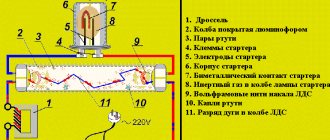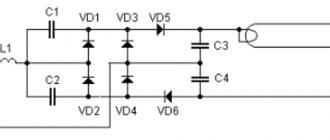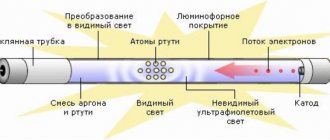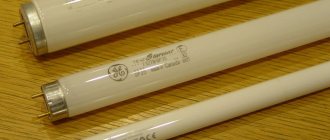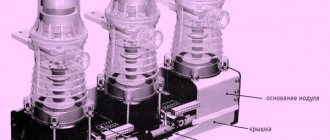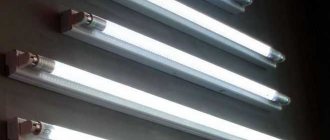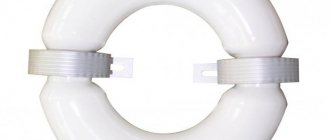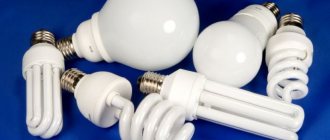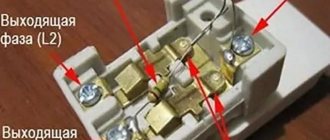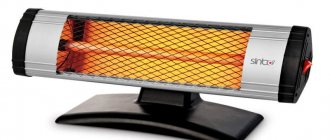A starter for fluorescent lamps is included in the package of an electromagnetic ballast (EMP) and is designed to ignite a mercury lamp.
Each model released by a specific developer has different technical characteristics, but is used for lighting equipment powered exclusively by AC power, with a maximum frequency not exceeding 65 Hz.
We suggest you understand how a starter for fluorescent lamps works and what its role is in a lighting device. In addition, we will outline the features of different starting devices and tell you how to choose the right mechanism.
How does the device work?
The optional starter (starter) is quite simple. The element is represented by a small gas-discharge lamp, capable of forming a glow discharge at low gas pressure and low current.
This small-sized glass cylinder is filled with an inert gas - a mixture of helium or neon. Movable and fixed metal electrodes are soldered into it.
All light bulb electrode coils are equipped with two terminal blocks. One of the terminals of each contact is involved in the electromagnetic ballast circuit. The rest are connected to the cathodes of the starter.
The distance between the starter electrodes is not significant, so it can easily be broken through by the mains voltage. In this case, a current is generated and the elements included in the electrical circuit with a certain amount of resistance are heated. The starter is one of these elements.
The designs of starters for fluorescent lamps have an almost identical device: 1 – choke; 2 - glass flask; 3 – mercury vapor; 4 – terminals; 5 – electrodes; 6 — body; 7 – bimetallic contact; 8 – inert gas substance; 9 – tungsten filaments LDS; 10 – drop of mercury; 11 – arc discharge in the bulb (+)
The flask is placed inside a plastic or metal housing that acts as a protective casing. Some samples additionally have a special inspection hole on top of the lid.
The most popular material for block production is plastic. Constant exposure to high temperatures allows it to withstand a special impregnation composition - phosphor.
The devices are produced with a pair of legs that act as contacts. They are made from different types of metal.
Depending on the type of design, the electrodes can be symmetrical movable or asymmetrical with one movable element. Their leads pass through the lamp socket.
A capacitor with a capacity of 0.003-0.1 μF is connected parallel to the electrodes of the flask. This is an important element that reduces the level of radio interference and is also involved in the process of lighting the lamp.
An obligatory part in the device is a capacitor capable of smoothing out extra currents and at the same time opening the electrodes of the device, extinguishing the arc that occurs between the current-carrying elements.
Without this mechanism, there is a high probability of contact soldering when an arc occurs, which significantly reduces the life of the starter.
In everyday life, the most popular types of ballasts are those with a symmetrical contact system and a starting electrical circuit. Such samples are less affected by voltage drops in the electrical network
Correct operation of the starter is determined by the supply voltage. When the nominal values are reduced to 70-80%, the fluorescent lamp may not light up, because the electrodes will not be heated sufficiently.
In the process of selecting the required starter, taking into account the specific model of a fluorescent lamp (fluorescent or LL), it is necessary to additionally analyze the technical characteristics of each type, as well as decide on the manufacturer.
Models
All products are manufactured exclusively using helium-hydrogen. At the same time, radioactive isotopes are not used in the production process. On the market today you can find a lot of modifications that are suitable for P3 sockets.
Products
All models from this manufacturer have a cylindrical shape and fire-resistant impregnation. The legs are installed with the heads. They have built-in orthogonal type capacitors with a capacitance that fluctuates around 5 pF. Such products are characterized by rare gap problems. The average failure rate of such models for luminescent varieties according to GOST is 0.2%. Ballasts here should be used of the electromagnetic type. The cost of such products will cost approximately 35 rubles.
Operating principle of the device
Having supplied mains power to the lighting device, the voltage passes through the turns of the LL inductor and the filament made of tungsten single crystals.
Next, it is brought to the contacts of the starter and forms a glow discharge between them, while the glow of the gaseous medium is reproduced by heating it.
Since the device has another contact - a bimetallic one, it also reacts to changes and begins to bend, changing its shape. Thus, this electrode closes the electrical circuit between the contacts.
The magnitude of the current generated by the glow discharge varies from 20 to 50 mA, which is quite enough to heat up the bimetallic electrode, which is responsible for closing the circuit (+)
A closed circuit formed in the electrical circuit of a luminescent device conducts current through itself and heats the tungsten filaments, which, in turn, begin to emit electrons from their heated surface.
In this way, thermionic emission is formed. At the same time, the mercury vapor in the cylinder is heated.
The resulting flow of electrons helps to reduce the voltage applied from the network to the contacts of the starter by approximately half. The degree of glow discharge begins to fall along with the glow temperature.
The bimetal plate reduces its degree of deformation, thereby opening the chain between the anode and cathode. The current flow through this area stops.
A change in its indicators provokes the appearance of an electromotive force of induction inside the choke coil, in the conductive circuit.
The bimetallic contact instantly reacts by producing a short-term discharge in the circuit connected to it: between the tungsten LL filaments.
Its value reaches several kilovolts, which is quite enough to penetrate the inert environment of gases with heated mercury vapor. An electric arc is formed between the ends of the lamp, producing ultraviolet radiation.
Since this spectrum of light is not visible to humans, the lamp design contains a phosphor that absorbs ultraviolet radiation. As a result, the standard luminous flux is visualized.
When the current in the circuit changes or stops completely, changes in the magnetic flux through the surface of the plate occur proportionally, which limits this circuit and leads to the excitation of a self-inductive emf in this circuit
However, the voltage on the starter connected in parallel with the lamp is not enough to form a glow discharge; accordingly, the electrodes remain in the open position while the fluorescent lamp is on. Further, the starter is not used in the operating circuit.
Since the current must be limited after the glow is produced, an electromagnetic ballast is introduced into the circuit. Due to its inductive reactance, it acts as a limiting device that prevents lamp failure.
Why does the light bulb glow when it is turned off?
This happens because when the switch is in the off position, the electrical circuit does not completely open due to the backlight powered through a resistance. Since the circuit is not open, a small voltage is supplied to the lamp, and this voltage is enough to light the lamp at about 5% power.
The most common reason for a lamp to glow after being turned off is backlit switches. Inside such a switch there is an LED with a current-limiting resistor. The LED lamp glows dimly when the light is turned off, because even when the main contact is turned off, voltage continues to flow through them.
Operating principle of a fluorescent lamp
The use of conductors as a current limiter allows one to significantly reduce the dimensions of such a circuit. This is what the power supply for a 10-15 W diode lamp looks like.
Expert opinion
It-Technology, Electrical power and electronics specialist
Ask questions to the “Specialist for modernization of energy generation systems”
Bypassing LED lamps with a capacitor There are many more different classification parameters and design options, but their number is constantly increasing. Ask, I'm in touch!
Types of starters for fluorescent devices
Depending on the operating algorithm, starting devices are divided into three main types: electronic, thermal and glow discharge. Despite the fact that the mechanisms have differences in design elements and operating principles, they perform identical options.
Electronic starter
The processes reproduced in the starter contact system are not controllable. In addition, the temperature regime of the environment has a significant impact on their functioning.
For example, at temperatures below 0°C, the heating rate of the electrodes slows down, and accordingly, the device will take longer to turn on the light.
Also, when heated, the contacts can be soldered to each other, which leads to overheating and destruction of the lamp coils, i.e. her damage.
Most models of electronic ballasts for LDS are based on the UBA 2000T microcircuit. This type of device allows you to eliminate overheating of the electrodes, thereby significantly increasing the service life of the lamp contacts and, accordingly, the period of its operation.
Even properly functioning devices tend to wear out over time. They retain the glow of the lamp contacts longer, thereby reducing its production life.
It was to eliminate this kind of shortcomings in the semiconductor microelectronics of starters that complex designs with microcircuits were used. They make it possible to limit the number of cycles of the process of simulating the closure of the starter electrodes.
In most samples presented on the market, the circuit design of the electronic starter is made up of two functional units:
- management scheme;
- high-voltage switching unit.
An example is the UBA2000T electronic ignitor chip from PHILIPS and the TN22 high-voltage thyristor from STMicroelectronics .
The operating principle of an electronic starter is based on opening the circuit by heating. Some samples have a significant advantage - the option of a standby ignition mode.
Thus, the opening of the electrodes is carried out in the required voltage phase and under the condition of optimal temperature indicators for heating the contacts.
The semiconductor elements of the electronic ballast must be suitable for key performance characteristics, namely, the ratio of the power value and the network voltage of the connected lighting device
It is important that if the lamp breaks down and unsuccessful attempts to start it of this type, the mechanism turns off if their number (attempts) reaches 7. Therefore, there can be no talk of premature failure of the electronic starter.
As soon as the light bulb is replaced with a working one, the device will be able to resume the LL start-up process. The only disadvantage of this modification is the high price.
In a circuit with a starter, as an additional method of reducing radio interference, balanced chokes with a winding divided into identical sections, with an equal number of turns wound onto a common device - the core, can be used.
Today, manufactured ballasts have a prefabricated rod design. The magnetic wire is cut from steel sheets. As a rule, such chokes have two symmetrical windings
All areas of the coil are connected in series order to one of the lamp contacts. When turned on, both of its electrodes will operate under the same technical conditions, thus reducing the degree of interference.
Thermal view of the starter
The key distinguishing characteristic of thermal igniters is the long start-up period of the LL. During operation, such a mechanism uses a lot of electricity, which negatively affects its energy-consuming characteristics.
Thermal starter is also called thermobimetallic. Heating of the contacts occurs at a slower rate, which effectively affects the operation of the lighting device in a low-temperature environment
As a rule, this type is used in low temperature conditions. The operating algorithm differs significantly from analogues of other types.
In the event of a power failure, the electrodes of the device are in a closed state; when applied, a pulse with a high voltage is formed.
Glow discharge mechanism
Starting mechanisms based on the glow discharge principle have bimetallic electrodes in their design.
They are made of metal alloys with different coefficients of linear expansion when the plate is heated.
The disadvantage of the glow discharge igniter is the low level of the voltage pulse, which is why the LL ignition is not sufficiently reliable
The possibility of igniting the lamp is determined by the duration of the previous heating of the cathodes and the current flowing through the lighting device at the moment the starter contact circuit opens.
If the starter does not light the lamp on the first pull, it will automatically repeat attempts until the lamp lights up.
Therefore, such devices are not used in low temperatures or unfavorable climates, for example, high humidity.
If the optimal heating level of the contact system is not provided, the lamp will take a long time to ignite or will be damaged. According to GOST standards, the time spent by the starter on ignition should not exceed 10 seconds.
Starting devices that perform their functions using the thermal principle or a glow discharge are necessarily equipped with an additional device - a capacitor.
Types of parts
To make the right choice, you need to know the technical characteristics of various models. Properly selected parts will not cause any trouble in operation. These days, the following types of lighters are especially popular:
- Smoldering row. Used in lamps with bimetallic electrodes. They are often purchased due to their simplified design. In addition, the ignition time is short.
- Thermal. Characterized by a longer ignition period of the light source. The electrodes take longer to heat up, but this has a positive effect on performance.
- Semiconductor. They operate on the principle of a key. After heating, the electrodes open, then a pulse is formed in the bulb and the light bulb lights up.
Thus, parts from the Philips Corporation are classified as smoldering. They are of the highest quality. The body material is fire-resistant polycarbonate. These igniters have built-in capacitors. No harmful isotopes are used in the production process. Installation is carried out using a regular screwdriver.
OSRAM products are characterized by the presence of a dielectric non-flammable housing made of macrolon. They additionally have capacitors installed that suppress interference (foil roll capacitors).
Popular and S models: S-2 and S-10. The former are used when igniting low-voltage models with a power of up to 22 W. The second ones are for igniting high-voltage fluorescent lamps with a wide power range (4-64 W).
The starter is one of the main components of lamps. Choosing the right one will guarantee long and uninterrupted operation of such light sources.
The role of the capacitor in the circuit
As noted earlier, the capacitor is located in the casing of the device parallel to its cathodes.
This element solves two key problems:
- Reduces the degree of electromagnetic interference created in the radio wave range. They arise as a result of contact between the system of starter electrodes and those formed by the lamp.
- Affects the ignition process of a fluorescent lamp.
This additional mechanism reduces the magnitude of the pulse voltage generated when the starter cathodes open and increases its duration.
The capacitor reduces the likelihood of contact sticking. If the device does not have a capacitor, the voltage across the lamp increases quite quickly and can reach several thousand volts. Such conditions reduce the reliability of lamp ignition.
Since the use of a suppression device does not allow achieving complete leveling of electromagnetic interference, two capacitors are introduced at the input of the circuit, the total capacitance of which is at least 0.016 μF. They are connected in series order with the middle point grounded.
Main disadvantages of starters
The main disadvantage of starters is the unreliability of the design. Failure of the trigger mechanism provokes a false start - several flashes of light are visualized before the start of a full-fledged light flux. Such problems reduce the life of the tungsten filaments of the lamp.
Starters generate significant energy losses and reduce the efficiency of the lamp device. Disadvantages also include voltage dependence and significant variation in the response time of the electrodes
With fluorescent lamps, an increase in operating voltage is observed over time, while with a starter, on the contrary, the longer the service life, the lower the glow discharge ignition voltage. Thus, it turns out that the switched on lamp can provoke its operation, causing the light to go out.
The open contacts of the starter turn on the light again. All these processes are carried out in a split second and the user can only observe flickering.
The pulsating effect causes irritation of the retina and also leads to overheating of the inductor, reducing its service life and failure of the lamp.
The same negative consequences are expected from a significant spread of contact system time. It is often not enough to fully preheat the lamp cathodes.
As a result, the device lights up after reproducing a number of attempts, which are accompanied by an increased duration of the transition processes.
If the starter is connected to a single-lamp circuit, then there is no way to reduce the light pulsation.
In order to reduce the negative effect, it is recommended to use this kind of circuit only in rooms where groups of lamps (2-3 samples each) are used, which must be included in different phases of a three-phase circuit.
Possible faults
The fluorescent tube does not light up. What could be:
- The incoming voltage from the network is less than 200 Volts. Under such conditions, the starter may not operate.
- Insufficient glow charge. Over time, this figure decreases. There comes a time when the electrodes will never close and need to be replaced.
- The heating time of the LDS cathodes is not enough. Requires replacement with a product with a long contact closure period.
The lighting fixture blinks:
- The reduced glow charge causes the starter to operate while the lamp is operating. Accordingly, the gas tube goes out, then lights up again. The product needs to be urgently replaced.
- There is a glow at the ends of the lamp , but the whole lamp does not light up. It is necessary to remove the starter; if the glow disappears, the starter needs to be replaced.
Explanation of marking values
There is no generally accepted abbreviation for starter models of domestic and foreign production. Therefore, we will consider the basics of notation separately.
Decoding the value 90C-220 looks like this: a starter operating with luminescent samples, the power of which is 90 W, and the rated voltage is 220 V (+)
According to GOST, the decoding of the alphanumeric values [ХХ][С]-[ХХХ] printed on the device body is as follows:
- [XX] – numbers indicating the power of the light-reproducing mechanism: 60 W, 90 W or 120 W;
- [C] – starter;
- [ХХХ] – voltage used for operation: 127 V or 220 V.
To implement lamp ignition, foreign developers produce devices with various designations.
The electronic form factor is produced by many companies.
The most famous on the domestic market is Philips , which produces the following types of starters:
- S2 are designed for power 4-22 W;
- S10 - 4-65 W.
OSRAM is focused on producing starters for both single and serial connection of lighting devices . In the first case, this is marked S11 with a power limit of 4-80 W, ST111 - 4-65 W. And in the second, for example, ST151 - 4-22 W.
Manufactured starter models are presented in a wide range. The key parameters taken into account during selection are commensurate values with the characteristics of fluorescent lamps.
What to look for when choosing?
When choosing a launcher, it is not enough to base it on the name of the developer and the price range, although these factors should also be taken into account, because... indicate the quality of the device.
In this case, reliable devices that have proven themselves in practice win. It is worth paying attention to such companies: Philips , Sylvania and OSRAM .
Starter FS-11 brand Sylvania. Suitable for fluorescent lamps with a power of 4-65 W. Can be used on AC power. Works on the glow discharge principle
The most basic operational parameters of the starter are the following technical features:
- Ignition current. This indicator should be higher than the operating voltage of the lamp, but not lower than the power supply.
- Base voltage. When connected to a single-lamp circuit, a 220 V device is used, and a two-lamp circuit uses a 127 V device.
- Power level.
- The quality of the housing and its fire resistance.
- Operational life. Under standard operating conditions, the starter must withstand at least 6000 starts.
- Duration of cathode heating.
- Type of capacitor used.
It is also necessary to take into account the inductive reaction of the coil and the rectification coefficient, which is responsible for the ratio of reverse to forward resistance at a constant voltage.
Additional information about the design, operation and connection of the ballast mechanism of fluorescent lamps is presented in this article.
Connecting a fluorescent lamp
Connecting such a device is simple and the electrical circuit also does not require special knowledge.
There are two connection methods - single-lamp and two-lamp:
- Single-lamp circuit. The lamp and inductor are connected in series to the power source, and the starter is mounted parallel to the lamp. A capacitor may be present at the input terminals of the glow tube to improve current characteristics.
- Two-lamp option. Two lamps and a choke are connected in series to the power supply system, and a starter is attached in parallel to each lamp. Wherein. the sum of the starter powers must correspond to the choke power.
To connect the starter, you need the device itself, as well as a de-energized phase. For added safety, you can use dielectric gloves or pliers with good insulation.
The starter is inserted into the groove intended for it and turned clockwise until it stops. Thus, the terminals are fixed on the conductive plates. This is subject to the factory lamp.
If you want to make it more reliable and stronger, you will need a soldering iron with solder.
Connecting an LDS without a starter:
Connecting the LDS with the starter:
